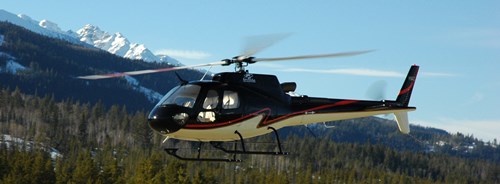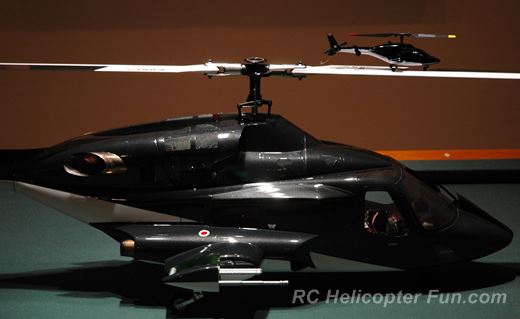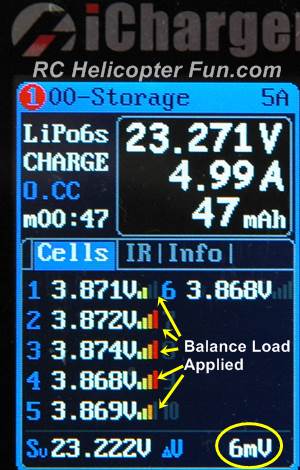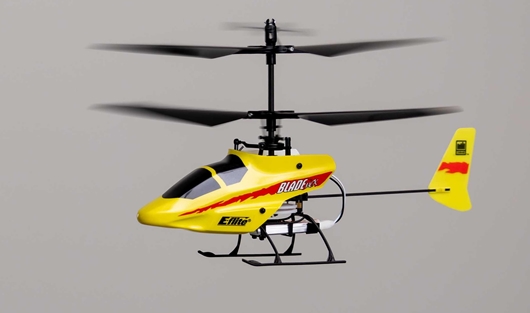Scale RC Helicopters: What You'll Need To Know Before Considering Scale.
How Does Scale Differ From Pod & Boom? What Types Are Available? Are They Harder To Build & Fly? How To Choose The Best For Your Experience Level.
by John Salt - Last Updated November 2024
Flying scale RC helicopters might be your long term RC helicopter goal. It certainly was mine when I was first getting into the hobby & still is to this day.
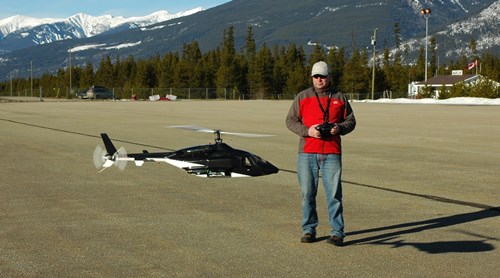 I Love Flying Scale RC Helicopters
I Love Flying Scale RC HelicoptersTo be perfectly honest, if I wasn't trying to cover and understand most aspects of rotary RC aircraft on this website; I would put every cent, every available minute, and every resource into scale.
Scale RC helis are my true passion & love in this hobby. If I was forced to give up every type heli I own/fly right now except one, the big scale birds would stay and the rest would go.
Video below shows one of my scale heli builds.
If you even have the slightest feeling scale might be something to strive towards as I did, that is a great goal and I encourage you 100% to follow that ambition. Scale after all is underrated and somewhat unappreciated. This stems from two opposing & completely opposite fronts...
First we have the 3D world demanding higher and higher power, lightning fast reacting collective pitch RC helicopters which are not well suited for scale or scale fuselage fitment.
Next we have the "Drone Noise" that is taking much of the focus & skill away from true RC helicopters (scale, sport, F3C & 3D).
Combine the two, and scale seems to be some sort of unknown not to mention the many misconceptions about scale RC helicopters.
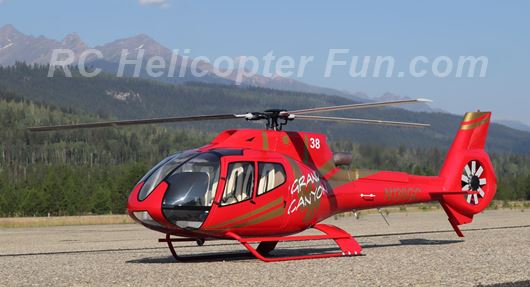 My First Fenestron Trail Rotor Scale RC Helicopter - Roban 800 EC-130
My First Fenestron Trail Rotor Scale RC Helicopter - Roban 800 EC-130Short on time? Scale type flying doesn't care...
One of the best things about scale RC helicopter flying is you don't need to practice all the time to stay sharp like you do with aerobatics and 3D. Seems we are all short on time these days and not feeling pressured to get out and practice all the time (for me anyway), can be a big positive when my plate is overflowing.
That's not to say flying a scale RC helicopter is easy, it actually requires & builds a whole new set of flying skills to correctly "emulate" how full size helicopters behave. This requires a super smooth and fluid flying style with a knowledge of what aerodynamic principles affect full size helicopters.
If you can appreciate all this and are thinking that "scale RC helicopters are definitely for me" GREAT; but you still must learn and become a proficient RC heli pilot on a Pod & Boom helicopter first.
What’s the difference between scale RC helis and pod & boom?
The majority of scale RC helis are fitted (covered or
skinned as I like to say) with a fuselage to resemble many different
types of real life, full size helicopters.
Pod and boom helicopters on the other hand are exactly that – a “POD” up front that encapsulates most of the helicopter mechanical systems. Exiting the back end of the pod is a long aluminum or carbon fiber tube called the “BOOM”. The tail rotor is then attached at the end of the boom.
 Trex 800E Pod & Boom RC Helicopter
Trex 800E Pod & Boom RC HelicopterPod and Boom RC helicopter design is by far the most common type and best RC helicopter choice when you are first starting out in the hobby. In fact, they are pretty much the only RC helicopter choice because most scale RC helicopters are generally nothing more than Pod & Boom mechanics covered by a scale fuselage.
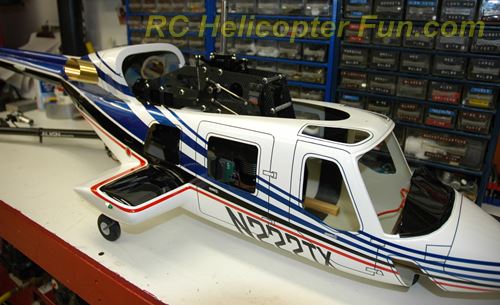 Mounting Pod & Boom Mechanics In Bell 222 Scale Fuselage
Mounting Pod & Boom Mechanics In Bell 222 Scale Fuselage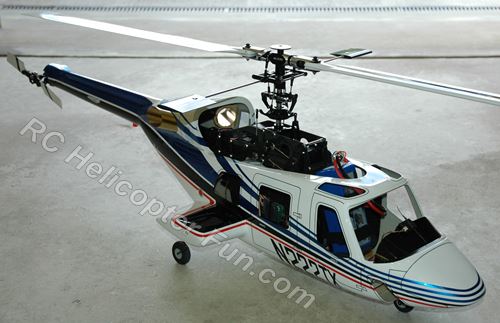 Scale Bell 222 Ready For First Test Flights. Not Completely Finished Just In Case Something Goes Horribly Wrong!
Scale Bell 222 Ready For First Test Flights. Not Completely Finished Just In Case Something Goes Horribly Wrong!Why Start Out With Pod & Boom?
There are three main reasons you want to start out and learn on a Pod and Boom heli:
1. Simplicity is key when you are starting out.
Fitting a scale fuselage over pod and boom mechanics is generally not easy and adds considerable complications and time to the build process.
You will also be making many adjustments (static and dynamic) to your helicopter at first after it's built and during the first few flights. These adjustments are much easier when you can see and get to everything on a Pod & Boom heli. A scale fuselage usually makes these adjustments more difficult.
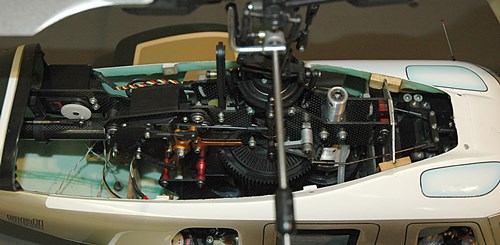 A Tight Fit!
A Tight Fit!As you can see from the above picture, stuffing your pod and boom mechanics into a fuselage limits the access to many components. Fitting the mechanics into the fuselage is generally not an easy task - there is lots of trial fitting, perhaps some trimming, usually some customization involved, and most definitely some cursing and head scratching.
I would never put brand new mechanics into a fuselage either. There are just too many unknowns with a fresh build from mechanical adjustments to FBL system programming. Only after several successful test flights of the mechanics in Pod & Boom configuration do I feel safe to fit them into a fuselage.
Here's a video I made showing a fairly typical scale RC helicopter mechanics install to give you a better idea of what's involved.
2. Fragile at Higher Costs & Weight.
Larger scale fuselages are not cheap. A good quality pre-finished fiberglass fuselage can cost as much or more than the pod and boom helicopter kit you are putting into it.
Whenever you fit a scale fuselage (from micro to monster), you increase the cost & weight; but the most import aspect of scale to realize is scale detail is fragile!
The more detailed, the more fragile it gets. This is also true of the less expensive RTF micro scale RC helicopters on the market such as XK's awesome little K123 AS350 (links to my full review).
You really must be a proficient RC helicopter flier before even considering scale - honestly!
Even a slightly hard landing that a Pod & Boom would survive will damage most scale RC helicopters. Most body shells are not designed to take impact forces. The landing struts or in some cases retractable gear are generally not as strong as beefy and springy pod & boom landing struts. The horizontal & vertical tail fins are not as strong, and the overall weight is up releasing more impact energy when things do go wrong.
Crashing a scale RC helicopter while learning would be very disheartening to say the least. A fuselage is pretty much a mangled pile of garbage even after a light crash.
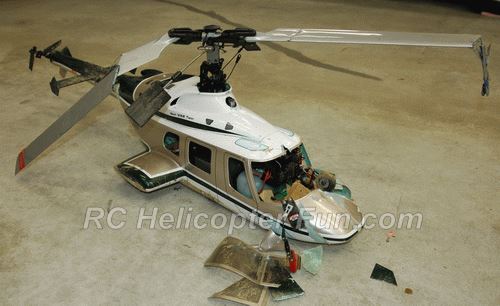 Light Crash - Major Damage!
Light Crash - Major Damage!3. You have to get a Pod and Boom heli regardless.
Remember, you generally get the fuselage separate and fit it over your pod and boom mechanics.
There are exceptions to this offered by a few manufacturers that have "Super Scale" kits. These special and more advanced scale RC helicopter kits come with special helicopter mechanics that are specifically sized and engineered to fit into their specific scale fuselages.
I discuss these higher end super scale models in more detail on the bottom 1/3rd of this page and why they are not the best choice for your first steps into scale helicopter flying.
Note, these points apply to larger collective pitch scale RC helicopters, not the small or micro size inexpensive ones you can find at places like Amazon. The point about fragile scale details however holds true for all sizes.
Best Scale RC Helicopter Fuselage Manufacturer (not super scale)
This is of course subjective, but in my opinion, one of the best pre-finished (meaning all painted) fuselages are manufactured by Fun Key Manufacturing (link takes you to my review on them).
Century Helicopter Products used to be Fun Key fuselage distributor in North America and many people thought Century Helicopter make these fuselages; but if you look at the name decal inside, they are in fact FunKey.
FunKey Manufacturing makes popular helicopter bodies to fit 550/30, 600/50, and 700/90 size RC Helicopter Mechanics. I am amazed each time I first set eyes on a new FunKey fuselage when I order one.
They seem to keep improving the quality with even more attention to detail. The fiberglass layup work is outstanding and the paint job is true automotive quality! Most of their bodies also have carbon fiber reinforcements in the high stress areas of the fuselage adding to the overall quality and strength.
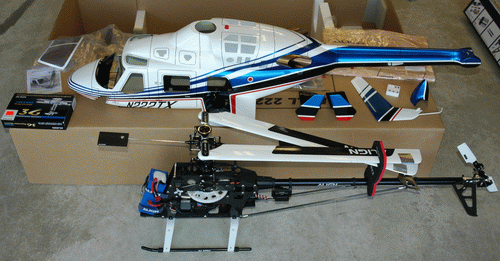
Here we have a typical scale FunKey fuselage right out of the box. This 600/50 size Bell 222 scale RC helicopter fuselage will be my fourth FunKey fuse and as I just mentioned, they make some of the nicest pre-finished bodies in the biz.
I am just doing a final sizing here to make 100% sure the pod & boom mechanics from an Align Trex 600ESP helicopter will fit and all the important measurements all line up. These Trex 600ESP mechanics have seen many test flights and I feel 100% confident that they will offer the bullet proof reliability I need for this scale RC helicopter project.
If
a scale RC helicopter is your goal and with that last point in mind
when deciding on your best RC helicopter kit; make sure the kit you get
will support the fuselage you want or vise-versa.
If you have a set of T-Rex mechanics for example and you like the Bell Jet Ranger, you can't just assume every Jet Ranger fuselage out there will fit it.
That is another thing I really like with FunKey's fuselages. They have a very good measurement schematics on every model they make taking most of the guess work out of it so you know your pod and boom mechanics should fit in the specific fuse you are considering.
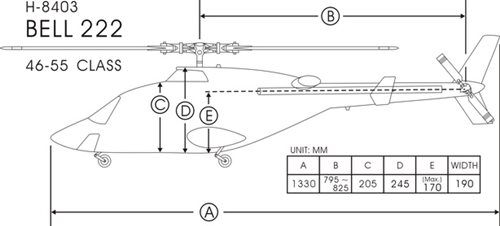
Above is a typical FunKey Sizing Schematic/Chart. With these few yet very critical dimensions listed, you can pretty much be 99% sure that your specific set of pod & boom mechanics will fit.
Scale RC Heli Fuselage Materials
One more item to consider is what the RC helicopter fuselage is made from; there are basically four in use today:
- Polystyrene is only used on mini RC toy helicopters. It's very inexpensive and light weight, but serves as a very good protective shell for these little toy helis. Unlike the scale RC airplane world where "foamies" have taken over; it's very doubtful we will ever see "foamie fuselages" for our scale RC helicopters.
- Polycarbonate is light and inexpensive. It is used mostly on micro to small size scale RC helicopter bodies. Cold weather makes polycarbonate very brittle; something you should consider if you fly outside in winter.
- Fiberglass is heavier and more expensive but stronger than polycarbonate. It's the by far the most popular and best RC helicopter material for larger helicopter canopies and fuselages from a price in relation to strength/weight/longevity ratio. Fiberglass handles the cold and vibrations better than polycarbonate. It also is fairly easy to make “good as new” repairs to fiberglass if it has suffered from light damage. Fiberglass auto body repair materials work very well for this.
 Repairs To Crash Damaged Fiberglass F3C Fuselage Using Fiberglass Cloth, Resin, & Light Weight Auto Body Filler
Repairs To Crash Damaged Fiberglass F3C Fuselage Using Fiberglass Cloth, Resin, & Light Weight Auto Body FillerI'm very happy with my fiberglass FunKey bodies.
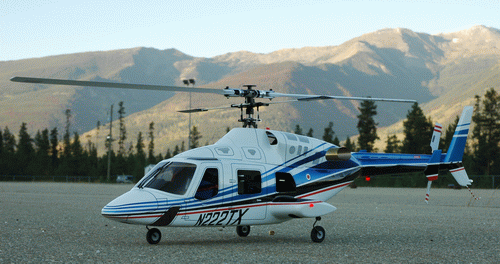 Funkey 600/50 Size Bell 222 Scale RC Helicopter
Funkey 600/50 Size Bell 222 Scale RC Helicopter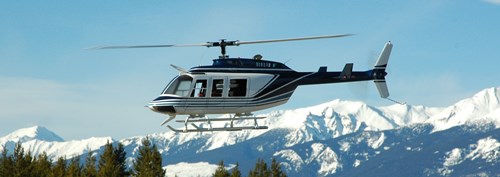 Funkey 600/50 Size Bell 206L (Long Ranger) Scale RC Helicopter
Funkey 600/50 Size Bell 206L (Long Ranger) Scale RC Helicopter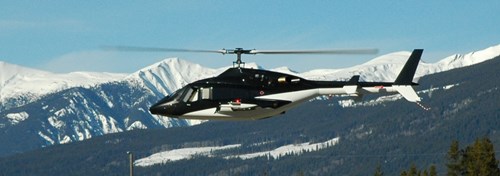 FunKey 600/50 Size AirWolf Scale RC Helicopter
FunKey 600/50 Size AirWolf Scale RC HelicopterHow To Determine Scale RC Helicopter Ratio To Full Size?
I actually just got this question and figured I should address it.
The person who contacted me was confused about RC helicopter sizing and how that relates to scale ratios of full size helicopters. He for example was looking for a 1:9 scale RC helicopter fuselage, but didn't know what size of RC helicopter to get for that overall scale ratio. The simple answer is there is no relation or correlation between RC helicopter sizing and scale ratios; let me explain...
You could have two different 600 size fuselages be totally different scale ratios to their full size counterparts. For example, a 600 size MD500 is going to be a larger scale than a 600 size Bell 222 because the full size MD500 is a smaller helicopter than the full size Bell 222. In fact, even though the two scale RC helicopters are roughly the same size using 600 mechanics, the scales can be substantially different.
For instance, a 600 size Bell 222 is about 1:9.6 scale, but the 600 size MD530 is about 1:6.2 scale.
To find the actual scale of any particular scale fuselage you are looking at, you simply get the overall dimensions of it, and then compare them to the overall dimensions of the full size machine to get the final scale.
For example, the FunKey 600 size Bell 222 fuselage is 1330mm long.
The full size Bell 222 fuselage is about 42' long (12,802mm); so the 600 size FunKey fuselage works out to a scale of about 1:9.6 (12,802mm/1330mm).
On the other hand, the full size MD500 is about 24' long (7315mm), and the FunKey 600 size MD500 is 1180mm long so the scale works out to about 7315mm/1180mm = 1:6.2.
By the way, to find the dimensions of full size helicopters, simply do a Google search for "dimensions of whatever helicopter" you want to know. Look at few different pages since there might be an error but if several pages all state the same or roughly same dimensions, you know it's a safe bet that is the actual size. I find length (nose to tail) is generally the best dimension to use in the calculation as it's the longest and therefore will give the best overall scale resolution between full size and the model.
Semi Scale vs. Super Scale RC Helicopters
All those FunKey scale RC helicopters pictured above are classified as "Semi Scale". This simply means they don't have the same level of detail & full scale interiors that "Super Scale" helis have. Semi scale also generally don't have working/opening doors which most super/full scale fuselages have and they are generally smaller (nothing bigger than a 700).
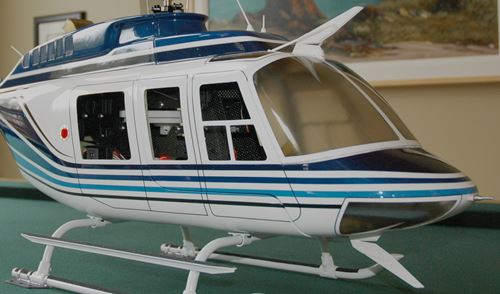 Semi Scale Bell 206L
Semi Scale Bell 206LThe first thing you will notice is you can see all the mechanics inside this semi scale heli.
This is the main distinction between semi scale & super scale.
There are other exterior details that super scale generally have that semi scale don't such as cable cutters, step plates & bars, bear's paws, antennas, pitot tubes, rivet detail, etc.
That however can all be added onto semi scale just as I have done on this Bell 206 Long Ranger.
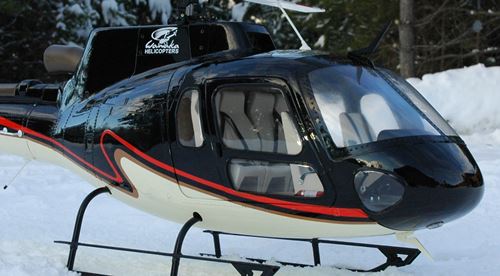 Super Scale AS350 Eurocopter
Super Scale AS350 EurocopterIn comparison on this super scale RC heli, you'll notice it has a full scale interior and all the mechanics are hidden.
This is achieved by using customized mechanics that are purpose designed for the particular scale body they are being installed in.
In other words, they are not simple pod & boom mechanics that you just install a fuse over.
Semi scale is by far the best way to introduce yourself to scale RC helicopters since it costs substantially less (both for the kit and taking into account you likely already have the pod & boom helicopter mechanics), takes less time to build, and is not nearly as finicky. Not to mention, not nearly as depressing if you happen to crash.
Once you have mastered semi-scale however, super scale is the next rewarding and fun step. As I mentioned below the video on the top of the page, making all the little scale details for inside the cockpit such as the fire extinguishers, seat belts, collective sticks, tail pedals and even dressing up what was included by adding more detail was so rewarding & relaxing. I know not everyone likes making little details like that, but if you do, you'd likely really enjoy super scale.
There are not many super scale RC helicopter manufacturers out there. The two most common are Vario Helicopters & Roban Models.
Vario is the higher end of the two, but you pay big coin for that quality. Roban on the other hand is more affordable, but the quality is not as good; in fact, FunKey's fiberglass and paint quality is better than Roban's. Still, for the price, Roban is hard to beat in my opinion.
Here is my unboxing video of their 800 size EC130 to give you an idea of what their overall quality is like.
Other large high end super scale RC heli manufacturers include: Alterbaum Premium Helicopters, Heli Classics, Heli Factory & Helikopter-Baumann.
These large, higher end scale RC helicopters are generally all turbine powered, but a few offer electric options too. Gas and nitro have been pretty much phased out.
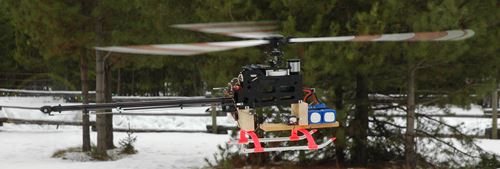 Super Scale Flight Test Platform
Super Scale Flight Test PlatformWhat on earth is that ugly thing you ask?!
Remember me saying earlier on in the article that "only after several successful test flights of the mechanics in Pod & Boom configuration do I feel safe to fit them into a fuselage"...
Well, this holds just as true for super scale. Since super scale mechanics are customized for particular fuselages and can only be flown once installed in the fuse, some folks will install them and hope for the best - NOT ME! I have been involved in this hobby way too long to take anything as complex as a fresh CP build for granted.
It took perhaps an extra hour at most to build that prehistoric looking test platform out of some 2x4 and 1x4 lumber along with an old set of landing skids/struts I had lying around, and then fit the super scale mechanics onto it. I then flight tested, flight tested, and you guessed it - flight tested some more.
Stuff like flybarless tuning, ESC programming, blade tracking, vibration analysis, post flight data analysis, etc.; I had it all sorted out before installing the mechanics into the fuselage. It was also much easier to access the mechanics for adjustments and I'm sure that alone saved well over an hour. For me, the little bit of extra effort to build this goofy looking test platform was well worth it and actually saved me time - maybe even a helicopter ;-)
The video below goes over this "testing" in more detail.
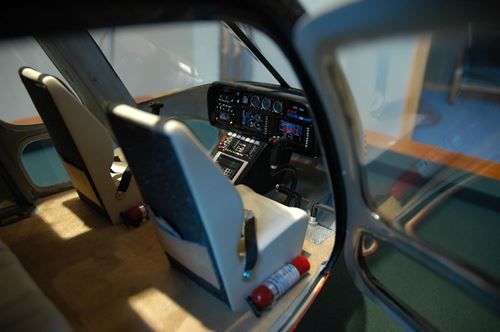 Roban Super Scale AS350 Interior
Roban Super Scale AS350 Interior